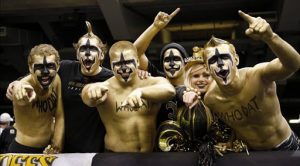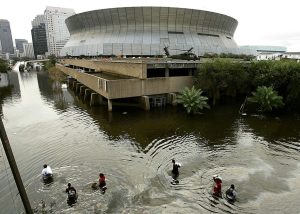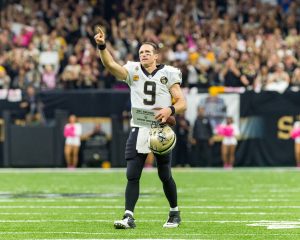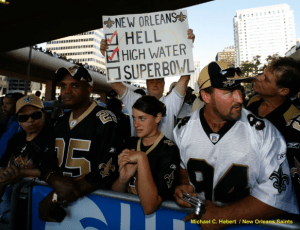When the Saints Go Marching In
The NFL Team that Rebuilt New Orleans, Time and Time Again
Published on April 9, 2020, at 7:28 p.m.
by Faith Saucier.
The New Orleans Saints have come a long way since their one-win season in 1980, when fans referred to the team as the “Aints” and even went so far as wearing paper bags over their heads to the games.
Today, game day attendees dress head-to-toe in black and gold gear — decked-out in life-sized whistle hats, robot costumes, or makeshift shields with fleur-de-lis plastered front and center. Paper bags be gone.
Win or lose, fans fight for the team with passion, spunk and a whole lot of pride.

Jeff Duncan, columnist at The Athletic New Orleans, has had his fair share of experiences with fans defending the Saints’ name. “People will defend the Saints here unlike any other team I’ve seen,” Duncan said. “If I write something negative about the Saints — which I have over the years — I will just get pilloried by a large segment of the fanbase because I’m basically taking a shot at the family. The Saints are family to people.”
When you’re born into a fandom — into that sports family — it’s likely that you will carry that love and loyalty with you until the day you die.
Adam Earnheardt, co-author of “Sports Fans, Identity and Socialization: Exploring the Fandemonium,” explained this idea further: “You might have family members who are born into that culture, and they begin to wrap their identity and socialize around that fandom,” Earnheardt said. “You’ll have children who are born into these families who know nothing other than becoming a fan of that team.”
Born into die-hard sports families, children in Louisiana are no different, wearing Saints jerseys in their first-ever baby pictures and dressing up like Drew Brees every year until they’re old enough to skip Halloween.
While these children may decide to leave the city once they grow up, their hearts will most likely be rooted in New Orleans — and with the Saints — forever.
The same goes for those displaced by Hurricane Katrina, one of the most destructive natural disasters in American history. “Some of those people never returned to New Orleans,” said Earnheardt. “They may have moved to Florida, Alabama or Texas — but when they moved, they took with them the love of New Orleans culture, and still celebrate that fandom for the Saints.”
“The Katrina Season” — Darkness turned to light
With an estimated $161 billion in damage, Hurricane Katrina remains the costliest hurricane in U.S. history.
But this storm took much more than money from the residents of Louisiana — specifically New Orleans. The storm took their houses, their family members, their lives and their hope. A city usually overflowing with light and warmth was darker and colder than it had ever been.

But on Sept. 25, 2006, the Saints came marching in.
After “The Katrina Season” — playing “home” games in Baton Rouge, San Antonio and New York — the team returned to the Superdome once again in an electric showdown against the Atlanta Falcons.
“There was such a buildup of anticipation for that game,” said Duncan. “They had a countdown banner on the side of the Superdome, so people driving by the dome would see those days ticking down — almost like the Christmas calendar in your living room — waiting for the game to finally be played.”
The game resulted in a Saints’ win of 23-3 on the NFL’s biggest stage, Monday Night Football. It was the first step to recovery for the city of New Orleans — a story for the ages. The city would rise again.
“As journalists, we’re supposed to be objective. We’re not supposed to root, and we don’t root,” said Duncan. “But you do root for stories — you root for the best story, and the best story was the Saints winning that game. It was a huge, cathartic moment for the city.”
The Saints lifted the city. Their return brought back hope, strength and maybe even a little normalcy to the people of New Orleans.
Duncan agreed: “At first, the Saints were lifting the city. They were an escape for people from the doldrums of rebuilding their homes, fighting with insurance companies, and everything that was involved in trying to get back to New Orleans and rebuild their lives.”
“The Saints bolted out to this 3-0 start and that really caught fire. The emotion of the city started to build up,” Duncan said. “The script flipped about halfway through the season, and all of a sudden, the Saints weren’t lifting the city. The city was lifting the Saints.”
What sports, culture and the Saints mean to New Orleans
New Orleans is filled with people of different races, classes and ethnicities. The city is rich in history and culture, defined by its incredible cuisine, music and nightlife. Its people are proud, reveling in the city’s distinctiveness, celebrating Saints football, and worshipping the “King of Louisiana,” Drew Brees.
The beloved quarterback has been a major player — on and off the field — in helping to rebuild New Orleans since Hurricane Katrina. He gave the city hope in the midst of devastation, delivered its first (and only) Super Bowl win four years later, and recently committed $5 million to the state of Louisiana in an effort to help fight the COVID-19 crisis.

Brees also gave Louisiana a love of football like it has never seen before, becoming a symbol of the Saints’ ability to cross all racial and class lines.
“Football is a part of the fabric and culture of the city,” said Duncan. “People go to the Saints games and it’s a communal experience, much like Mardi Gras or Jazz Fest.”
“There are certain events that unite us all; and all of the divisions we have, whether they are class or racial — whatever they might be — they all kind of fade away for those three hours on a Sunday. For those three hours, everybody’s family,” Duncan noted.
The success that Brees and the Saints have brought to the city is rarely overlooked and never forgotten: “When the Saints go on a run, there’s nothing like it. You can start to feel it in the city,” Duncan said. “It becomes a New Orleans story as much as it is a football story. That’s what these sports teams do — they give you an identifier, something to be proud of civically.”
The branding behind sports, and what we can learn
Our identification with a sports team is directly influenced by how we socialize with others who possess the same identity, according to Earnhardt.
The communities and cultures surrounding a sports team are significant when it comes to fan identification and branding on behalf of sports teams. “The brand has a lot to do with the identity that a team instills in the community,” explained Earnheardt. “If there’s something about the way a team plays — or the way they instill parts of the culture into their team, and into the experience of being a fan of that team — that’s extremely important.”
The concept of family is important, too. Earnheardt stated that “when you think about this idea of identity, you think about the first group you identify with, and that’s your family.”
“We then take cues from that family on how to act — our beliefs, values, morals, temperaments, talents and convictions,” he said. “That’s really no different than what sports teams do. They play on that family aspect in many ways. They want it to be a family experience.”

Other brands can learn from the way that teams engage with their audiences.
“If you can tap into the same kind of motivations that sports teams do with their fans, that’s a winning combination in really just about any industry,” said Earnhardt.
“We know people watch sports because they want to be entertained, relax or forget about the world around them. These other ideas, such as family, socialization and being connected to something bigger … if you find a way to tap into those, that’s a win.”
Sports give people hope. Teams instill strength into communities. Games provide fans with an escape — a chance to simply “let it all go” for a few hours on a Sunday afternoon.
It’s a striking thought: That a band of athletes, coaches and staff can make fans feel like family, whether it be through a television screen or from the perfect seat on the 50-yard line; that teams bring out the best in people, or make fans feel like they belong to something that’s greater than themselves.
But as fascinating as that all may be, it’s quite a reality for sports fans across the nation. It’s what you can do for the “fans” of your brand.
It’s what the Saints did, and continue to do, for the people of New Orleans.




